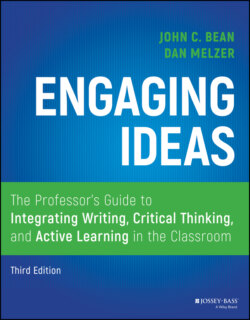Читать книгу Engaging Ideas - John C. Bean - Страница 21
Signature Features of Engaging Ideas
ОглавлениеIn keeping with these premises, therefore, the third edition retains—and in some cases improves or extends—the following signature features:
It takes a pragmatic nuts‐and‐bolts approach to teaching critical thinking, giving teachers hundreds of suggestions for integrating writing and other critical thinking activities into a disciplinary course.
It integrates theory and research from the writing in the disciplines literature with the broader literature from the scholarship of teaching and learning on critical thinking, intellectual development, active learning, and modes of teaching.
It gives detailed practical assistance in the design of formal and informal writing assignments and suggests time‐saving ways to coach the writing process and handle the paper load.
It treats writing assignments as only one of many ways to present critical thinking problems to students; it shows how writing assignments can easily be integrated with other critical thinking activities, such as use of small groups, inquiry discussions, classroom debates, and interactive lectures.
It has a separate chapter devoted to academic reading, exploring the causes of students' reading difficulties and offering suggestions for promoting more engaged and deeper reading.
It has separate chapters devoted to small groups and to increasing critical thinking in discussion or lecture courses.
It devotes a separate chapter to teaching undergraduate research and proposes alternatives to the traditional research paper.
It assumes that there is no one right way to integrate writing and critical thinking into a course; it therefore provides numerous options to fit each teacher's particular personality and goals and to allow flexibility for meeting the needs of different kinds of learners.
It emphasizes writing and critical thinking tasks that focus on the instructor's subject matter goals for the course, thus reducing, and in some cases perhaps even eliminating, the conflict between coverage and process.
It offers a wide array of ways to use writing in courses, ranging from short write‐to‐learn microthemes to major research projects and from formal academic writing to personal narratives; it also offers numerous ways to work exploratory writing into a course, including in‐class freewrites, blogs, and thinking pieces posted on class discussion boards.
It devotes a separate chapter to the creation of rubrics for grading student writing, discussing the upside and downside of rubrics. It also devotes a chapter to the art of providing effective feedback in ways that can minimize teacher time while maximizing helpfulness and care.
The third edition now contains two additional signature features: richer focus on self‐assessment, reflection, and peer review and alternatives to traditional grading (see the material noted in the “What's New” section).
